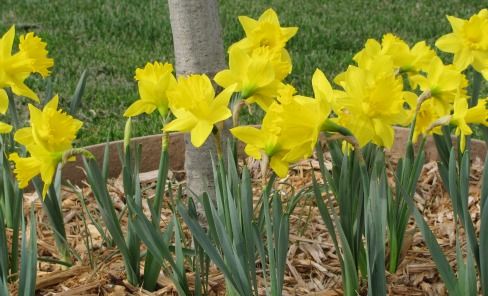
Last fall, my daughters and I carefully planted tulips, daffodils and hyacinth bulbs in our landscape beds. This week the bulbs announced their presence by coloring our dull yard with splendid color. A display of color that winter cannot provide.
Digging holes and planting bulbs last fall, with the help of an eight, three and one year old, was exhausting! I don’t want our hard work (and my stress) to go to waste; I want the same beautiful display next year without all the fall digging. In order to insure success, my first defense is fertilizer. Fertilizing when the leaves first emerge or right before they bloom will give them the nutrients they need to flower this year and begin storing food for next year. The American Daffodil Society recommends a 5-10-10 fertilizer. Personally, I use a water soluble fertilizer. You can use a dry fertilizer, just be sure to water it after you sprinkle it on the soil.
My second defense will be deadheading. Deadheading is when you remove the flower from the stem once the petals fade and/or fall off. If you left the flower on, the plant would send nutrients up the plant to create the seed pod. When the flower is removed the plant sends nutrient in the bulb, giving it a jump start on next year’s flower.
And my third and last defense will be to leave the green foliage alone until it turns yellow. It’s tempting to cut the foliage when you deadhead. Resisting the temptation will give you bigger blooms next year. The leaves, through photosynthesis, make food for the bulb and next year’s flower. Once yellow you can cut the leaves off at the ground.
Fertilizing, deadheading, and leaving the green foliage, will produce another spring of gorgeous blooms. The spring color is rewarding. I’m sure when fall rolls around I will plant a few more bulbs with my three little helpers (I really do like it when they are digging with me, stress and all)!





